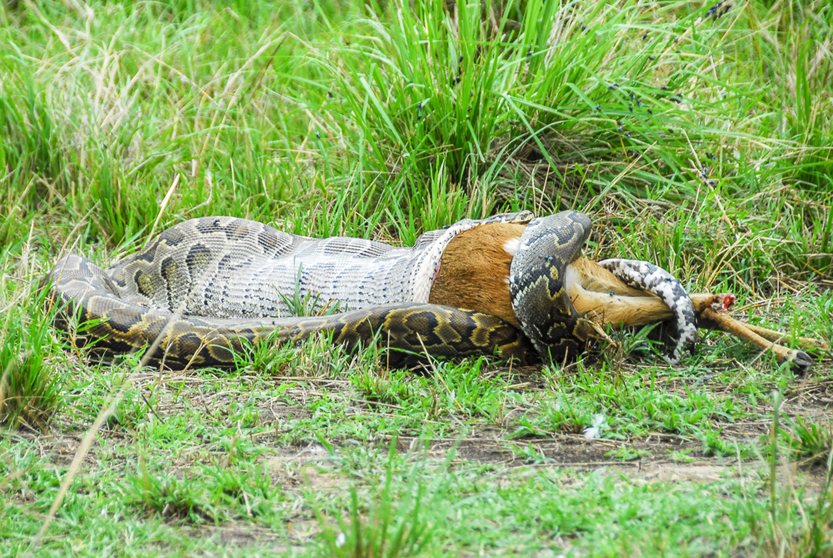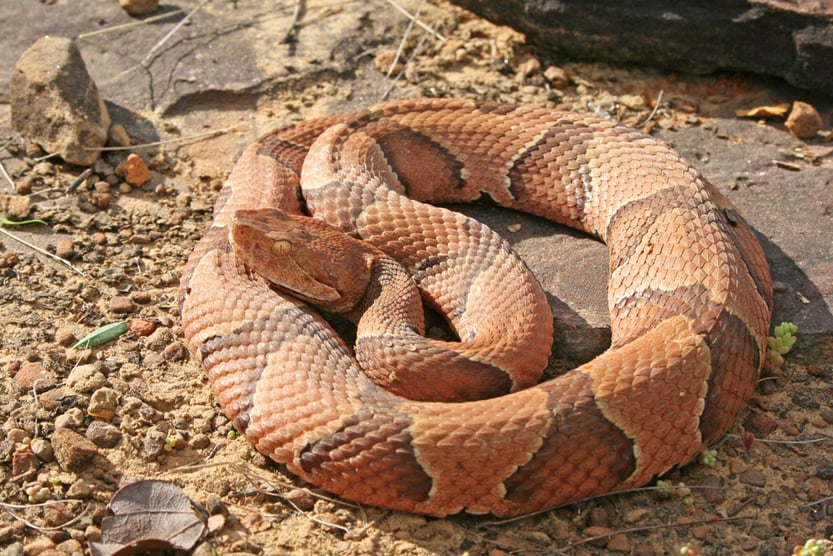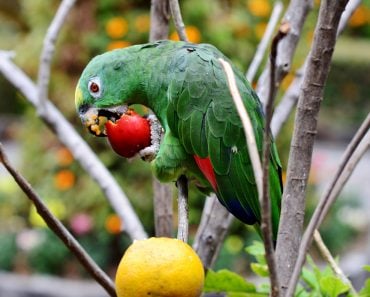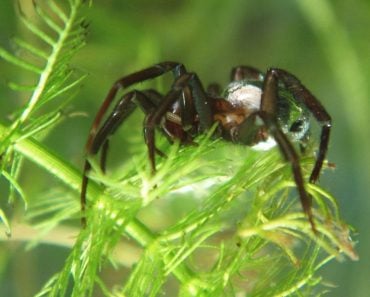Table of Contents (click to expand)
Snakes swallow their food whole. Sometimes their meal is a small rodent, while snakes like pythons and boas can eat animals like ibexes whole! The secret to how they manage to digest such large prey lies in their stomach and metabolism.
Some people make a big deal of chewing their food properly. Take Horace Fletcher, for example. Known as ‘The Great Masticator’, Fletcher recommended that people chew their food 32 times before they swallow. “Nature will castigate those who don’t masticate” is one of his more memorable quotes.
Snakes have clearly not heeded Fletcher’s advice.
Every nature documentary on snakes seems to have a scene dedicated to a snake swallowing its food whole. Every grim movement is followed by the camera as the snake inches its jaw slowly over its victim. For bigger snakes, like anacondas, boas and pythons, prey can be as big as a fully grown deer!
So, how do snakes, especially the big-game eaters, digest their prey whole—skin, hair, bones and all?
Recommended Video for you:
Snake’s Digestive System
Superficially, snakes have many of the same components as the human digestive system. The digestive system spans the length of a snake’s fat, rope-like body, starting with the mouth or the buccal cavity, and extending into the stomach.
Snakes usually feast on smallish prey, such as rodents, birds, lizards and occasionally other snakes. For larger prey, the snake has a “walking jaw”. The two halves of its jaw can operate separately and sort of “walk” over their large prey, swallowing it head first. The curved fangs prevent the animals from escaping, digging in deeper as the animal struggles to escape (if the animal is still alive).
The meal then makes its way down (or through?) the esophagus to the stomach.

A snake’s stomach, like many other stomachs in the animal kingdom, secretes a cocktail of acid (hydrochloric acid) and digestive enzymes to break down the food.
From the stomach, we move on to the small intestine. The snake also has a pancreas, a liver, and a gall bladder that secrete digestive enzymes into the intestine. The intestine absorbs the nutrients into the bloodstream. From the small intestine, we move to a sort of large intestine-like space.
The snake is able to digest most of the animal it eats, including the bones. The only parts that remain are hair, which is made of a resistant protein called keratin, as well as calcium from the bone. This the snake excretes in the form of pellets.
Strategies To Eat Large Prey
The champions of eating—boas and pythons—have a unique system that allows them to digest, say, a 130-pound antelope, which an African rock python has been recorded to have eaten.
Many large animal-eating snakes are ambush hunters, like the Burmese python, that lies in wait for prey to stumble into its path. They eat infrequently, but snag larger prey than their more frequently eating and actively hunting serpent counterparts. In between meals, these infrequent feeders decrease their metabolic activity to a bare minimum, which means reducing the size of its digestive system too!

Beefing Up
However, when they’re ready to feed, and prey is secured, the snakes amp up their metabolism 2 to 3 fold! That is basically like sprinting right after you wake up from a deep sleep. They beef up their heart muscles and circulatory system to help them pump more blood and boost their digestive system by almost three times. Imagine if your digestive system put on a few pounds just to digest lunch!
This is all in preparation for the marathon of digestion!
Once the prey enters their stomach, the organ will begin secreting acid and digestive enzymes. In the span of a few hours, the pH of the stomach drops from 7.5 to 2 and then to 1.5. In this bag of gastric juice, the animal, whether it’s an ibex, antelope or alligator, will be broken down, skin, flesh, bones and all. The strong stomach muscles will churn and blend the food, in a way, substituting for the work of teeth.
The snake manages to digest all of this because, unlike many mammals that only keep their food in their stomach for a few hours to a day, the snake’s stomach continues to digest its meal for several days or even weeks, depending on the size of the meal. A fortnight-long assault of 1.5 acid is enough to dissolve most organic matter (except keratin, the protein that composes hair and nails).
The liquefied meal makes its way into the intestine, where it is further broken down and the newly thickened lining of the intestine absorbs all of these nutrients.

Tradeoffs Of Eating Large Prey
This several weeks-long digestion takes a lot of energy. The snake must expend resources to create and secrete enzymes and acid and to move muscles that aid in digestion, among other metabolic considerations. The snake also increases its oxygen intake to about the same levels as when you might exercise, or when a racehorse runs.
In fact, the pythons can use half the energy they get from their large meal to actually digest the meal!
This also puts the snake in a vulnerable position. At the start of digestion, when the snake is practically immobilized from the giant bulge of food in its stomach, other predators could threaten the snake. If the threat becomes unavoidable, the snake may vomit its meal out and flee the scene, although this isn’t great for the snake’s digestive system.
Furthermore, an antler or horn may damage or entirely rupture the snakes internal organs, which can cause the snake to fall ill or die. Trying to eat something much too big can even cause the snake to explode, as was recorded when a python tried to eat an alligator that was simply too big for it.

Speaking of explosions, the second drawback is putrefaction. Soon after the snake ingests its prey, whether it is a rat or an ibex, the prey will start to rot. The bacteria in the animal will begin to decompose, which can cause the animal to bloat and increase in size. If the snake has eaten something that’s already quite large, it can’t afford to let its meal get any bigger. Putrefaction also brings with it a powerful stink, toxic chemicals produced by bacteria, and infection. The snake’s digestive system is essentially racing against the bacteria.
To prevent this, snakes can keep themselves nice and warm. Snakes are cold-blooded animals, which means that their body mimics the external temperature. In turn, how their organs function will also depend on the temperature. Warmer temperatures speed up digestion, so snakes will often sunbathe to get their body primed to digest.
In colder regions, snakes like vipers and rattlesnakes use their highly toxic venom to digest their prey from the inside out. The venom, along with its toxins, contains digestive enzymes that break down the animal from the inside. Thus, the snake doesn’t have to use extra energy trying to only digest its prey from the outside.
A Final Word
There is one snake species that does break its food—crabs—into smaller chunks. It breaks the crab into chunks by ripping its legs off, for example. This is the closest to chewing that scientists have documented in snakes. It just goes to show how much about nature we still don’t fully understand!
References (click to expand)
- Secor, S. M., Taylor, J. R., & Grosell, M. (2012, January 1). Selected regulation of gastrointestinal acid–base secretion and tissue metabolism for the diamondback water snake and Burmese python. Journal of Experimental Biology. The Company of Biologists.
- Secor, S. M. (2008, December 15). Digestive physiology of the Burmese python: broad regulation of integrated performance. Journal of Experimental Biology. The Company of Biologists.
- Secor, S. M. (2003, May 15). Gastric function and its contribution to the postprandial metabolic response of the Burmese python Python molurus. Journal of Experimental Biology. The Company of Biologists.
- Secor, S. M. (2005, April 1). Evolutionary and Cellular Mechanisms Regulating Intestinal Performance of Amphibians and Reptiles. Integrative and Comparative Biology. Oxford University Press (OUP).
- Secor, S. M., & Diamond, J. (1997, March). Determinants of the Postfeeding Metabolic Response of Burmese Pythons, Python molurus. Physiological Zoology. University of Chicago Press.













